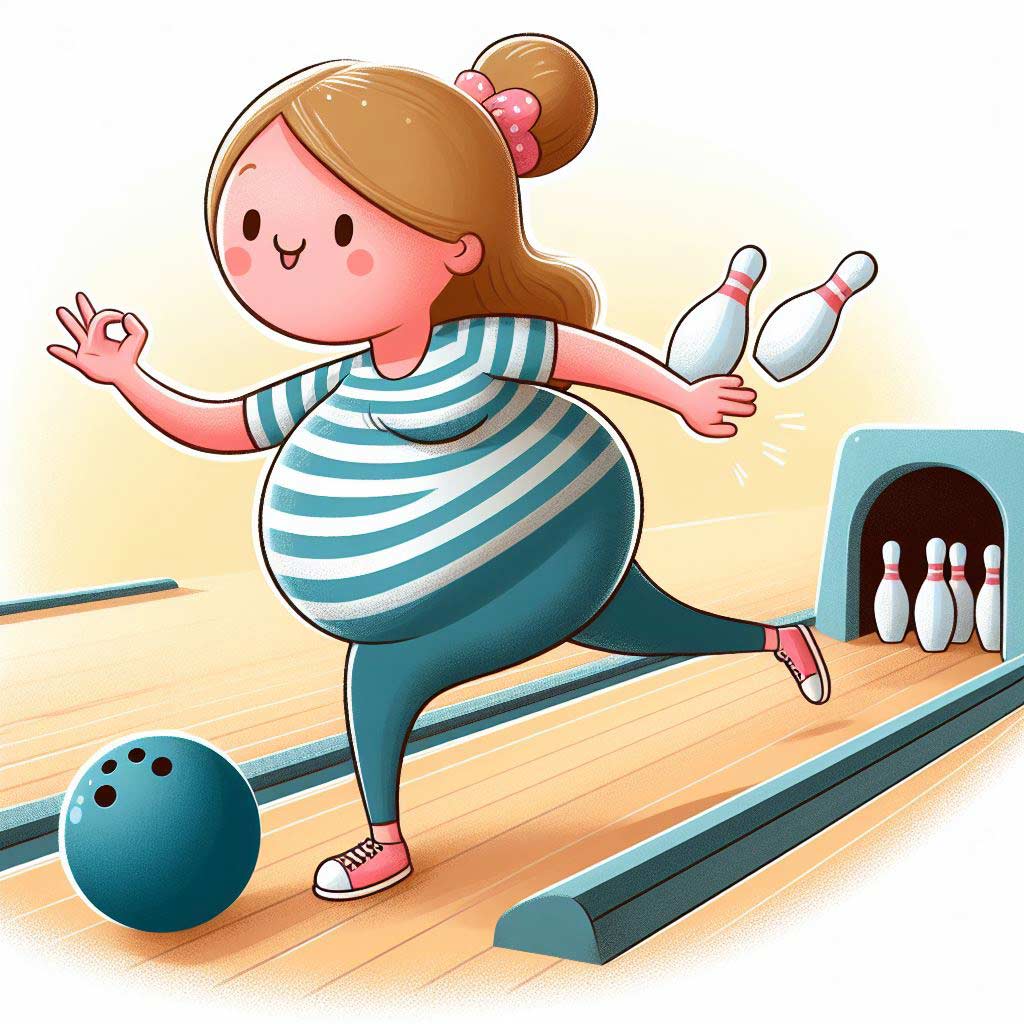Bowling is a popular recreational activity and a mild form of exercise enjoyed by millions of people worldwide. The question often comes up of whether it is safe to bowl during pregnancy.
Many expecting mothers want to know if their favorite hobby is off-limits for the next 9 months or if they can still head to the lanes for an evening of strikes and spares.
The good news is that bowling can absolutely be an option for moms-to-be, at least during the first and second trimesters. With a few simple precautions and safety considerations, bowling can offer some great benefits for both mom and baby. Of course, as with any exercise routine, it is wise to consult your doctor about any activity during pregnancy.
This article will explore the pros and cons of bowling while pregnant so you can decide if hitting the alley for some prenatal pins is right for you.
We’ll go over the potential benefits, risks to be aware of, tips for staying safe, and when to avoid bowling during pregnancy. Let’s lace up those bowling shoes and learn how to hit the lanes safely!
The Benefits of Bowling While Pregnant
If done carefully, bowling can be a fun, low-impact activity with a number of potential upsides for expecting moms, including:
Mild Exercise
Bowling provides a gentle form of exercise during pregnancy, especially in the first and second trimesters.
The walking approach and underhand swinging motion used to roll the ball can keep the heart rate up mildly and muscles engaged without jarring movements or risk of abdominal injury.
According to the American College of Obstetricians and Gynecologists, at least 150 minutes of moderate-intensity exercise per week is recommended during pregnancy for health benefits. Bowling can be part of that routine.
Social Activity
Many women enjoy bowling as a social activity with friends or family. Maintaining social connections and engaging in recreational activities you enjoy can be beneficial during pregnancy for mental health. Being part of a team or bowling league allows you to stay active with others.
Sense of Normalcy
Bowling may be something you did frequently before pregnancy. Continuing a familiar hobby can provide a sense of normalcy as your body goes through many physical changes and adjustments.
Rather than giving up an activity you love for 9+ months, bowling is one hobby pregnant women may be able to continue with few modifications.
Balance and Coordination
Bowling requires balance, core strength, and hand-eye coordination. The motion of bowling can help expecting moms maintain these skills during pregnancy as the body’s center of gravity shifts. Keeping up activities requiring balance and coordination may make adjusting to bodily changes easier.
Potential Risks and Precautions
While bowling has benefits, there are some potential risks pregnant women should be aware of. Taking simple precautions can help minimize any dangers. Potential concerns include:
Falling
One of the main risks of bowling while pregnant is losing balance and falling, particularly later in pregnancy as the belly grows larger. Falls put the baby at risk of injury, so maintaining stability and balance is key.
Wearing bowling alley shoes rather than slick street shoes can help prevent slips, as can using a ramp or grip aids if needed. Avoid leaning or overextending when throwing the ball.
Joint Pain
The weight of pregnancy combined with bowling’s swinging motion could strain joints like wrists, elbows, or shoulders if proper form is not used.
Discomfort, inflammation, or damage to joints should be avoided to prevent ongoing issues. Use an appropriate ball weight, minimal backswing, and proper release technique. Use two hands if needed to reduce shoulder strain.
Improper Bowling Ball Weight
Lifting a heavy bowling ball repeatedly can strain the abdominals, lower back muscles, or pelvic floor. Using an appropriate weight ball for your fitness level and pregnancy stage is key – no more than 10 pounds is recommended.
As pregnancy progresses, opt for a lighter 6-8 lb ball to avoid undue strain. Do not power through pain or discomfort from an overly heavy ball.
Bowling Safety Tips
If you want to stay safe while bowling during pregnancy, keep these tips in mind:
- Use a ramp or grip aid if needed for balance/stability
- Wear bowling alley shoes to prevent slips/falls
- Stay hydrated and take breaks between games
- Avoid greasy/slippery foods served at bowling alleys
- Use proper lifting technique – bend knees, keep back straight
- Opt for a lighter ball (6-10 lbs max) to avoid strain
- Use two hands and minimal backswing when bowling
- Maintain good posture and align shoulders/hips when throwing
- Stop bowling if you experience pain, contractions or other issues
By taking some simple precautions, you can make bowling a fun pregnancy activity for as long as it remains comfortable. Don’t be afraid to enlist help carrying or throwing the ball either. The key is listening to your body and not overexerting yourself.
When to Avoid Bowling While Pregnant
While bowling is generally safe in the first and second trimesters, there are times when it is better to avoid it or get your doctor’s okay first. Some circumstances when bowling may be off-limits include:
- High-risk pregnancy – If you have pregnancy complications like preeclampsia, talk to your OB.
- Third trimester – Bowling is not recommended in the final months as balance shifts and strain increases.
- Pain or discomfort – Stop bowling if you experience unusual pain, contractions, etc.
- The doctor advises against it – Always get your provider’s exercise guidance for your situation.
- History of falls/injuries – Added risk of harm from falls may mean avoiding bowling.
Listen to your body and your doctor’s advice. Stop bowling if you have any concerns or experience warning signs to avoid potential injury. Don’t feel obligated to bowl if uncomfortable.
Conclusion
Bowling can be an enjoyable form of safe exercise and recreation during the first and second trimesters of pregnancy for many women, provided some precautions are taken.
The light activity, social interaction, and sense of normalcy can make bowling a beneficial hobby before the baby arrives. Just be sure to use an appropriate ball weight, maintain proper form, and discontinue bowling if pain or complications develop.
Consulting your obstetrician can help you decide if hitting the lanes is right for you during this special time. With a little care and common sense, you can have fun bowling safely even when pregnant!
Frequently Asked Questions
Which activity should be avoided during pregnancy?
- Contact sports like hockey, boxing, soccer, and basketball should be avoided during pregnancy as they carry a high risk of abdominal trauma and falls which can harm the baby. Activities with jarring motions like horseback riding are also not recommended.
What chores should you avoid while pregnant?
- Pregnant women should avoid chores involving heavy lifting, harsh chemicals, standing for long periods, or climbing on ladders/stools. Examples include lifting heavy objects, cleaning with bleach or ammonia, prolonged standing or bending, and cleaning gutters.
Can I toss and turn while pregnant?
- Some tossing and turning during pregnancy is normal, but try to sleep on your left side and avoid lying flat on your back for long periods. Use pillows for support. Frequent repositioning at night is fine, just avoid sudden jerky movements that could strain the abdomen.
What to avoid during early pregnancy to avoid miscarriage?
- To reduce miscarriage risk in early pregnancy, avoid smoking/drinking alcohol, limit caffeine, minimize strenuous exercise, don’t lift heavy objects, avoid hot tubs/saunas, stay away from chemicals/toxins, and don’t have sex with penetration/orgasm in the first trimester. Also, avoid falls and abdominal trauma.
What fun activities can pregnant ladies do?
- Safe, fun activities for pregnant women include swimming, prenatal yoga, walking, low-impact aerobics, bowling, light cycling, painting/crafting, dancing, beginner pilates, massage therapy, movie/concert outings, and picnics. Social and recreational activities are encouraged.
What can’t you do in early stages of pregnancy?
- In early pregnancy you should avoid contact sports, scuba diving, heavy lifting, hot tubs/saunas, eating unpasteurized foods, changing cat litter, and flying after 36 weeks. Miscarriage risk is also higher with smoking, alcohol use, or penetrating sex. Always check with your doctor about restrictions.
Can I do squats while pregnant?
- Yes, body weight or low-weight squats are generally safe in pregnancy as long as they are done carefully without straining and while maintaining good form. Avoid deep squats past 90 degrees because this can restrict blood flow. Check with your doctor before performing any new exercise.
How much weight can you lift when pregnant first trimester?
- In the first trimester, avoid lifting more than 20 pounds repeatedly. Even lighter lifts should be done carefully using proper form – lift with legs bent, back straight, and weight close to body. Overexertion can be dangerous in early pregnancy when miscarriage risk is higher.





